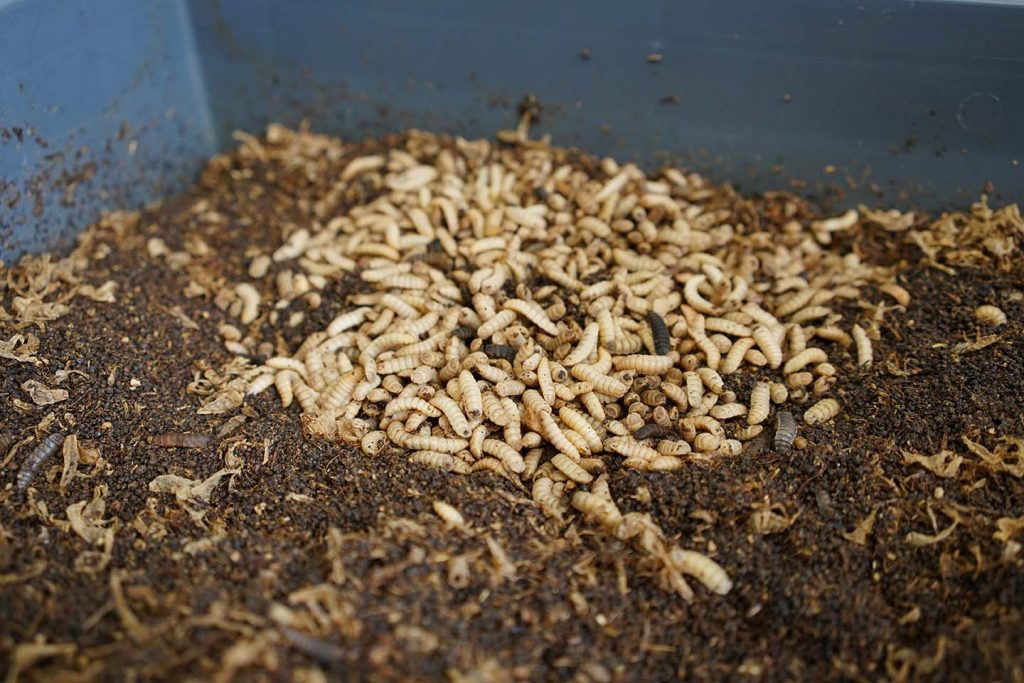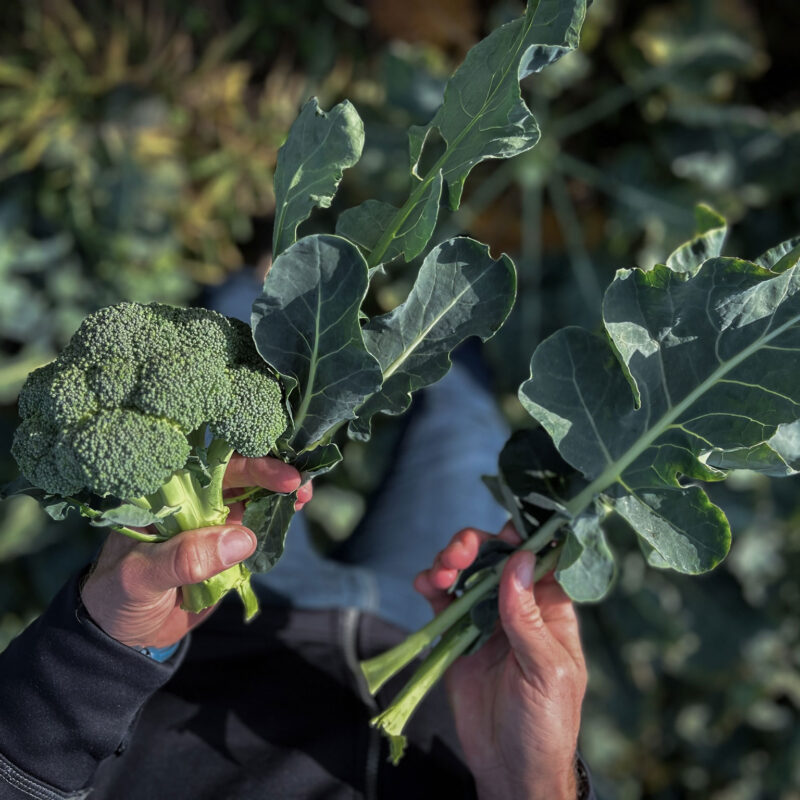Circular-based feed turns Swedish rainbow trout green
2021.11.10

Sweden's first green rainbow trout now available in stores and restaurants. Instead of soybeans and wild-caught fish from all corners of the world, the rainbow trout have eaten a circular feed mainly consisting of insects, which have themselves been fed on food waste.
An innovation from Axfoundation and the Swedish University of Agricultural Sciences (SLU) has resulted in Sweden’s first green rainbow trout now available for consumers. Instead of feeding on soybeans and wild-caught fish from all corners of the world, the rainbow trout have instead eaten a Swedish circular-based feed that mainly consists of insects, which have themselves been fed on food waste.
“It is a huge waste of resources to let farmed fish eat soybeans from Brazil and fish from the Pacific Ocean, whilst tons of food are thrown away in Sweden. Food waste can instead be used to raise insects, an excellent feed for fish. Our food should preferably not be eating our food,” says Madeleine Linins Mörner, Program Director for Future Food at Axfoundation.
Over 90 percent of the world’s commercial fish stocks are maximally fished or overfished. Farmed fish has often been seen as a possible solution to meet the increased demand for seafood, without increasing pressure on the world’s oceans. At the same time however, conventional fish feed often is made up of imported wild-caught fish. Furthermore, soybeans, a crop that results in great rainforest deforestation, is also usually included in fish feed.
By bringing together actors from the entire food chain, fish farmers, feed manufacturers, food wholesalers, restaurants and grocery stores, Axfoundation and SLU, with the support of Axfood, Sorundahallarna, Urban Deli and Älvdalslax, have proven that it is possible to grow an environmentally friendly and tasty fish in Sweden on a large scale. Through a pilot project that was co-financed by Sweden’s innovation agency, Vinnova, a green sustainable rainbow trout of high gastronomic quality has been farmed.
The rainbow trout has been fed a diet of Swedish circular-based fish feed made from, among other ingredients, insects, which have themselves been fed on vegetable waste and bread leftovers from the Swedish food industry. The insects convert the food waste into a protein that can be used as feed to produce more food, a circular solution that should be able to be used to a far greater extent than is today.
“It is entirely possible to turn the food industry’s waste from a cost into a resource and farm seafood on a large scale, whilst simultaneously reducing eutrophication in the Baltic Sea,” says Anders Kiessling, Professor at the Swedish University of Agricultural Sciences.
In addition to insects, the fish feed also includes other raw materials that humans do not normally eat, such as sea urchins, a protein-rich aquatic animal that eats phytoplankton. The sea urchin therefore extracts nutrients from the sea and contributes to reducing eutrophication.
“One of the major challenges in fish farming is to develop more sustainable feed solutions. Through this project we have shown that by taking advantage of food waste, it is possible to develop fish feed based on insects, and avoid importing soybeans. By being able to use even more waste streams, such as household waste, it would be possible to scale up this type of business and have more sustainable seafood production, which is important for us to play a part in,” says Axfood’s sustainability manager Åsa Domeij.
The entire four tons of the farmed rainbow trout went on sale the week commencing November 8 in selected Hemköp stores and at selected restaurants, including Urban Deli in Stockholm.
In addition to Axfoundation and the Swedish University of Agricultural Sciences, partners in the project are Axfood, Eskilstuna Strängnäs Energy and Environment, Fazer, Fiskhallen Sorunda, Grönsakshallen Sorunda, Härnösand Energy and Environment, Lantmännen, Marine Feed, Raisio, Restaurant and Hotel Academy Grythyttan at Örebro University, Örebro University, Tebrito, Vattenbrukscentrum Norr AB and Älvdalslax.
Comments from partners:
Älvdalslax:
“When we took over the family business some years ago, we did so as we believed in the need for quality Swedish-produced food. We want to provide a sustainable alternative, so it is an obvious choice for us to constantly work to improve the wellbeing of the fish, both for the sake of the environment and also because it creates fish products of the highest quality. The fact that we can now play a part in the production of the first sustainable Swedish rainbow trout that is farmed using a Swedish circular-based feed, one that makes the fish grow well and taste so fantastic, makes us really proud,” says Anders Beronius, co-owner of Älvdalslax who raised the green rainbow trout in the Österdal river.
Sorundahallarna:
“We see fish farming as a prerequisite for us to be able to continue to serve fish in the future, but we must ensure that it becomes a truly sustainable alternative. It is important for us at Sorundahallarna to be involved in driving the development of sustainable food and the fact that we managed to produce a fish with a fantastic taste and color was a big bonus. Not having to compromise on taste and quality when making sustainable choices is an incentive to get more people to make such choices,” says Louise Söderqvist, Deputy Marketing Manager at the Sorundahallarna wholesaler.
Urban Deli:
“The green rainbow trout is unique as it tastes wild-caught, even though it is farmed. The fish has a special kind of character and gives a greater taste experience in a dish. This type of project is very important to us at Urban Deli as we are constantly working to find sustainable alternatives that have a positive impact on the climate. With a circular-based feed, fish are being grown in a sustainable way, eating their natural food – which is a more natural step in the debate about the protein of the future than us putting cooked insects on the menu ,” says Jessie Sommarström, Creative Director at the Urban Deli restaurant.
10 facts on fish and feed
- According to FAO (the UN’s food and agricultural organization) it is estimated that 90 percent of the world’s commercial fish stocks are maximally fished or overfished.
- In Sweden, 12.5 kilos of cleaned fish and shellfish are consumed per person annually.
- 70 percent of the seafood that is consumed in Sweden is imported, mostly from Norway, Denmark and China.
- Swedish consumers consume mostly salmon, herring, cod and shrimp. The salmon consumed in Sweden is almost exclusively of imported farmed Norwegian salmon.
- About half of all seafood in the global market is farmed. 60 percent of the seafood consumed in Sweden is wild-caught and 40 percent farmed.
- The majority of farmed fish consumed in Sweden is raised on feed made from imported raw materials, often from the four corners of the world. Conventional feed often consists of wild-caught fish, soybeans, usually from Brazil, as well as cereals such as wheat.
- A total of 1.3 million tons of food is thrown away every year in Sweden, of which 75 percent comes from households. Swedish wholesalers are estimated to annually produce 100,000 – 300,000 tons of vegetable waste, usually consisting of shell remains, stalks and kernels, but also fruits and vegetables with aesthetic defects. In total, about 80,000 tons of bread is thrown away.
- Just under 40 percent of all food waste from consumption is currently used to make biogas or bio-fertilizer for agriculture. The rest is used to make heat and electricity. Food waste could instead be used more resource-efficiently by being recycled and used in the food chain in the form of an animal feed.
- Since 2017, the EU allows the use of insects in feed for farmed fish. Since September 2021, it is also allowed to use insects when farming poultry and pigs. According to EU law, only vegetable waste that has come about before the consumer stage may be used as raw material in the breeding of insects. In other words, this does not include household food waste or slaughterhouse waste. In Canada, food waste from all levels is allowed, while certain hazardous substances are banned.
- Over 70 percent of Swedish consumers are positive about eating animal foods raised on insects. On the other hand, putting insects on the menu for human consumption is not seen as attractive.

The rainbow trout is available for consumers in selected Hemköp stores and at selected restaurants in Stockholm, among them Urban Deli.

The rainbow trout has been fed Swedish circular-based fish feed made from, among other ingredients, insects, which have themselves been fed on vegetable waste and bread leftovers from the Swedish food industry.
Contact:
- Linda Andersson, Director of Communications, Axfoundation
linda.andersson@axfoundation.se, +46 (0)73 – 087 15 70 - Madeleine Linins Mörner, Program Director Future Food, Axfoundation
madeleine.morner@axfoundation.se, +46 (0)70-950 35 35 - Anders Kiessling, Professor at the Department of Animal Nutrition and Management, Aquaculture, Swedish University of Agricultural Sciences,
anders.kiessling@slu.se, +46 (0)70-391 93 99 - Magnus Törnblom, Press Contact, Axfood,
magnus.tornblom@axfood.se, +46 (0)70-266 27 12 - Maya Johansson, Marketing Manager, Urban Deli,
maya.johansson@urbandeli.se, +46 (0)72-146 19 28 - Louise Söderqvist, Deputy Marketing Manager, Sorundahallarna,
louise.soderqvist@gronsakshallen.se, +46 (0) 70 450 58 43 - Anders Beronius, Owner Älvdalslax,
anders.beronius@alvdalslax.se, +46 (0)70 – 335 23 52
Related material
- Photos: Press photos and photos from feed production with insects, salmon farming and serving are available at MyNewsdesk.

























































